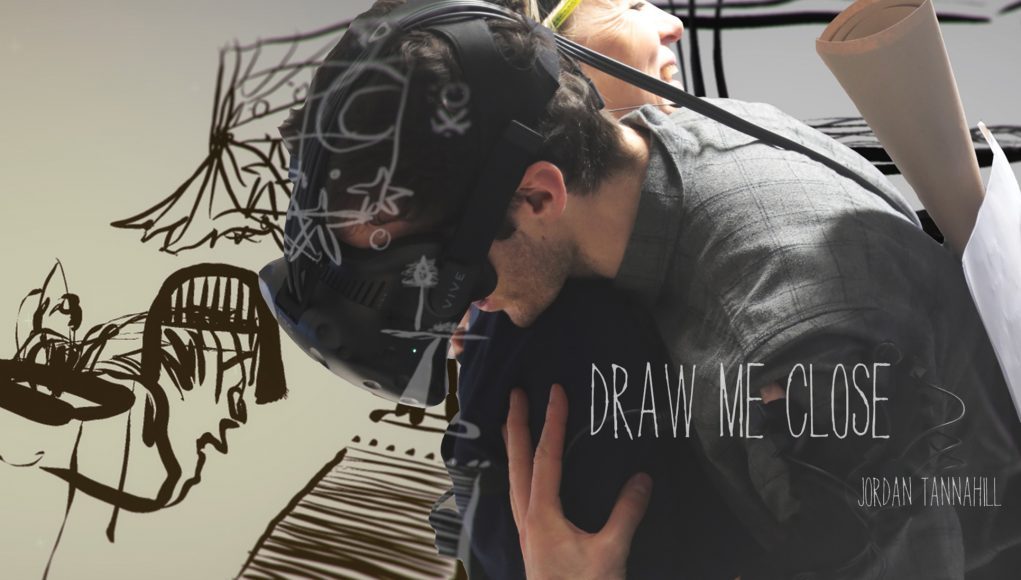 The National Theatre has created an Immersive Storytelling Studio to better understand the practices, protocols, opportunities of how virtual and augmented reality technologies are creating new storytelling possibilities. They collaborated with the National Film Board of Canada on an immersive theater piece called Draw Me Close that premiered at Tribeca Film Festival. It featured a one-on-one interaction with a live actor in a mixed reality environment while the audience was unveiled within a virtual reality headset where you play the archetypal role of a son/daughter as your mother embraces you, draws with you, and tucks you into bed as she narratives a memoir of her life. I talked with Immersion Storytelling Studio producer Johanna Nicolls about the reactions, intention, and overall development of Draw Me Close, which is their first immersive theater VR piece.
The National Theatre has created an Immersive Storytelling Studio to better understand the practices, protocols, opportunities of how virtual and augmented reality technologies are creating new storytelling possibilities. They collaborated with the National Film Board of Canada on an immersive theater piece called Draw Me Close that premiered at Tribeca Film Festival. It featured a one-on-one interaction with a live actor in a mixed reality environment while the audience was unveiled within a virtual reality headset where you play the archetypal role of a son/daughter as your mother embraces you, draws with you, and tucks you into bed as she narratives a memoir of her life. I talked with Immersion Storytelling Studio producer Johanna Nicolls about the reactions, intention, and overall development of Draw Me Close, which is their first immersive theater VR piece.
LISTEN TO THE VOICES OF VR
The spatial storytelling techniques and skills that theater has been developing for hundreds of years translates really well to the even more immersive 360-degree, VR environments. But with live experiences like Sleep No More and Then She Fell, there’s also a whole other ‘immersive theater’ movement within the theater world that is bringing new levels of embodiment, choices, and agency into authored theater performances.
No Proscenium podcast host Noah Nelson wrote up a great introductory primer of immersive theater that explores the nuanced differences between immersive theater, site-specific performances, and environmentally-staged theater. One differentiation that Nelson makes is that immersive theater has much more of an explicit experiential design that “feels more like an event you experienced than a performance that you witnessed.”
The version of Draw Me Close that I saw at Tribeca took a powerful first step in exploring how live actors sharing the same physical space within a mixed context provides a new dimension of emotional and embodied presence. The haptic feedback of an embodied hug from a co-present human is something that may never be able to ever be fully simulated in VR, and so this illustrates a clear threshold to me of what can and cannot currently be done in VR.
I also saw the Then She Fell immersive theater piece which featured a lot of one-on-one interactions with performers, and so I think that there’s a profound depth of emotional presence and intimacy that you can achieve with another person without the barriers of technology. You still can’t see the more subtle microexpressions of emotion or perceive the more nuanced body language cues when interacting with other humans while you’re in VR, but feeling the actor touch me provided a deeper phenomenological sense of embodied essence that I was interacting with an actual human in real-time. Directly interacting with another physically co-located person and feeling their touch closed some perceptual gaps and took my sense of social presence beyond the normal levels I have in distributed social VR experiences.
This was also such a new type of experience that I didn’t know the rules of engagement for how much I was expected to speak or interact. There weren’t a lot of prompts for talking or engaging, and so I mostly silently received the story as each moment’s actions were being actively being discussed, analyzed, and contextualized by a steady stream of real-time narration. There were not a lot of prompts, invitations, or space made available for dialogue, but there were a number of interactive actions I was invited to do ranging from opening a window to drawing Tilt Brush-style on the floor. There was a deliberate decision to be fairly vague in casting a magic circle of the rules and boundaries of what to expect, since the story, characters, and loving embrace of a motherly hug was all designed to be a surprise. This shows the challenging issues of balancing how to receive explicit consent to being touched while also maintaining the integrity of the mystery of a story that’s about to unfold.
Draw Me Close is an ambitious experiment to push the storytelling possibilities that are made available within a one-on-one interaction of an immersive theater piece while the audience is within virtual reality. It was a profound enough experience for a number of people who needed to have some level of decompression and help transitioning back from exploring some of the deeper issues that were brought within the experience.
There are obviously limitations for how this type of experience could be scaled up so that it was logistically feasible to be shown on a wider scale, but it’s refreshing to see the NFB and National Theatre’s Immersive Storytelling Studio experiment, explore, and push the limit for what’s even possible. If too much effort is focused on what’s sustainable or financially viable, then it could hold back deeper discoveries about the unique affordances of combining immersive theater with immersive technologies.
Explore Further:
- Here’s some footage from Draw Me Close at Tribeca by Steve Rosenbaum
- Here’s a trailer for Draw Me Close
Support Voices of VR
- Subscribe on iTunes
- Donate to the Voices of VR Podcast Patreon
Music: Fatality & Summer Trip







